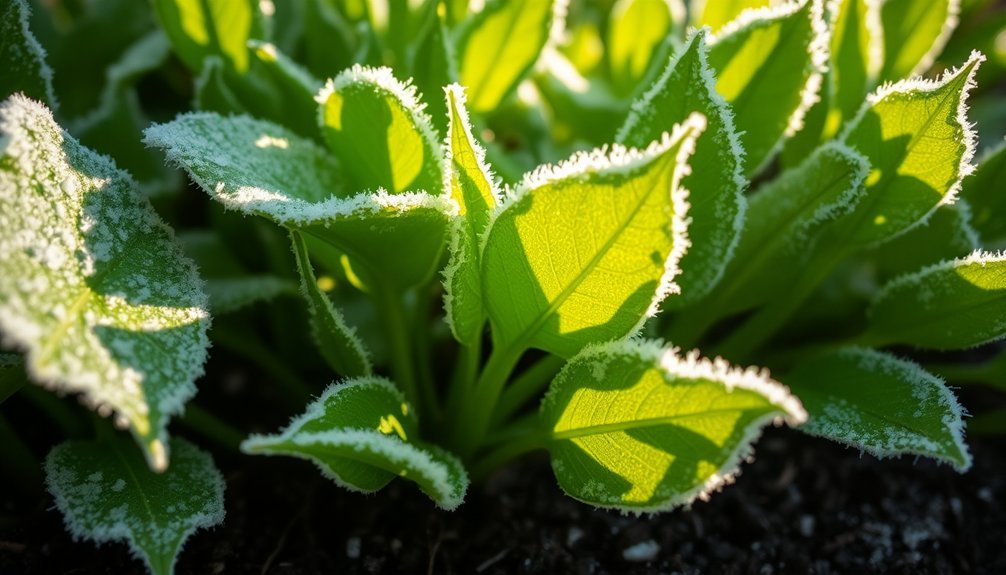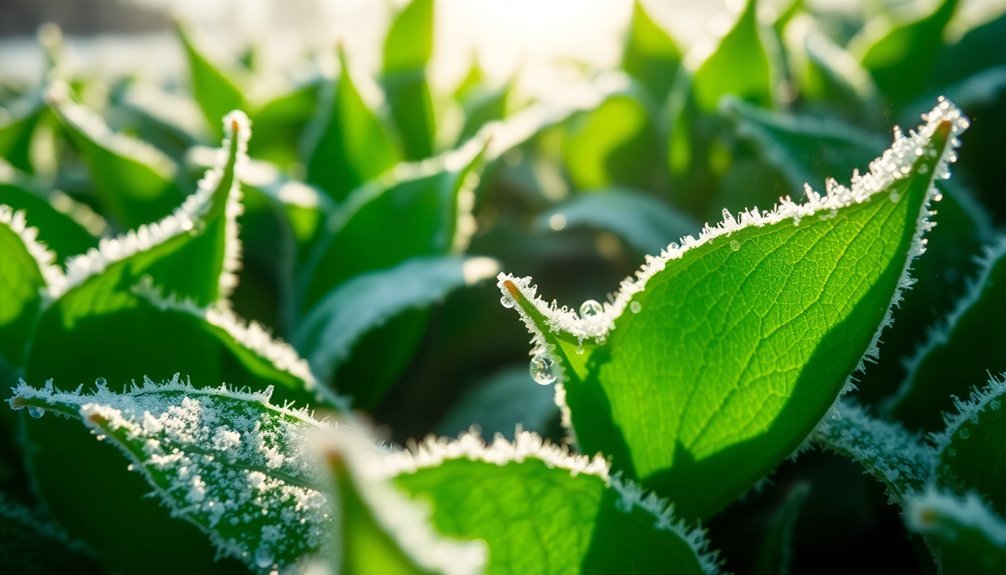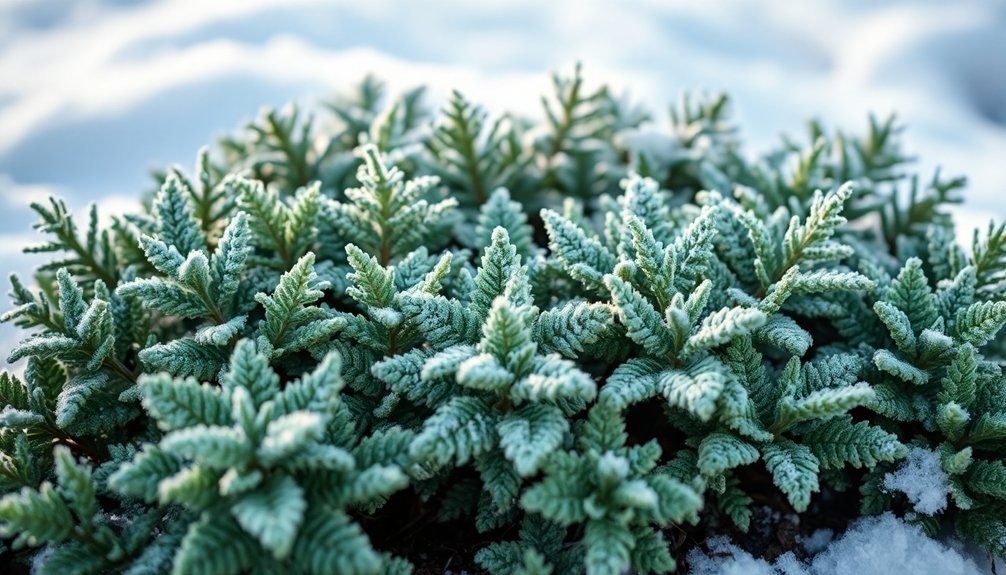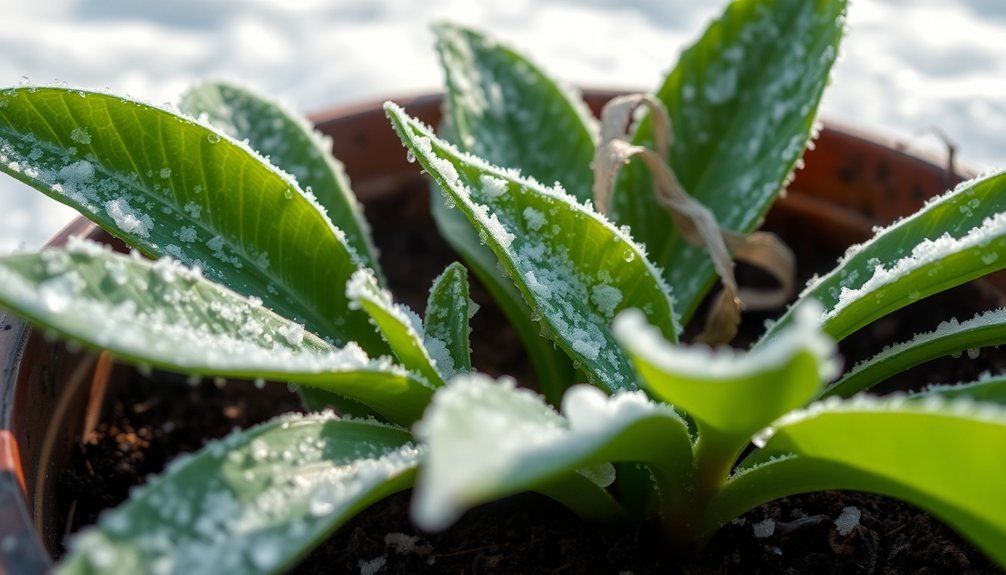To keep your air-filtering plants thriving in winter, provide bright indirect light near south or west-facing windows and maintain temperatures between 65-75°F. You'll need to reduce watering frequency and monitor soil moisture carefully during these dormant months. Group plants together to create humidity-rich microclimates, and keep them away from cold drafts and heating vents. Discover how specific species like Snake Plants and Peace Lilies can maximize your indoor air quality this season.
Essential Winter Light Requirements for Air-Filtering Plants

While winter's shorter days present unique challenges for indoor air-filtering plants, you can maintain their health by understanding and meeting their light requirements. Your air-filtering plants need bright indirect light to thrive, so place them near south or west-facing windows where they'll receive maximum sunlight exposure during these darker months.
Don't worry if some of your plants, like Peace Lilies, adapt to lower light conditions – they'll still purify your air, just at a slower growth rate.
You'll want to start regularly rotating indoor plants to guarantee all sides get equal light exposure, promoting balanced growth. If natural light isn't sufficient, you can supplement with grow lights that provide the specific spectrum needed for photosynthesis.
This combination of strategic placement and artificial lighting will keep your air-purifying plants healthy throughout winter.
Optimal Temperature Control Strategies for Indoor Flora
Beyond proper lighting, maintaining the right temperature is key to keeping your air-filtering plants thriving through winter.
You'll want to keep indoor temperatures between 65°F and 75°F to support ideal temperature control during the growing season. Install a thermostat to prevent harmful fluctuations that could stress your indoor plants.
Position your air-filtering plants away from cold drafts near windows and doors to prevent leaf drop. For extra protection, consider using heating mats to promote root health in potted plants during colder months.
Don't forget about humidity levels – aim for 50-60% to counter the drying effects of your heating system. While your plants mightn't be actively growing, these temperature control measures will help them maintain their air-purifying abilities throughout winter.
Maintaining Proper Humidity Levels During Dry Months

When winter heating systems kick in, indoor humidity levels often plummet below the 30-50% range that air-filtering plants need to thrive. You'll need to take action to protect humidity-loving plants like peace lilies and Boston ferns, which directly impact your indoor air quality through their filtering abilities.
| Plant Type | Humidity Needs | Best Solution |
|---|---|---|
| Peace Lily | High | Daily Misting |
| Boston Fern | Very High | Humidifier |
| Snake Plant | Low | Pebble Tray |
| Spider Plant | Moderate | Grouping |
| Pothos | Moderate | Group Misting |
You can create a beneficial micro-climate by grouping your plants together, allowing their natural transpiration process to increase local humidity. Consider using a humidifier for consistent moisture levels, or place water-filled pebble trays beneath your plants. Regular misting provides an additional boost, especially for moisture-loving species.
Winter Watering Adjustments for Plant Health
Since indoor plants naturally slow their growth during winter months, they require considerably less water than during active growing seasons.
You'll need to adjust your watering schedule by checking the top inch of soil and waiting until it's dry before adding more water. This practice helps prevent root rot, which commonly occurs from overwatering during winter's reduced light conditions.
For your air-filtering plants like Peace Lilies and Snake Plants, it's essential to maintain proper soil moisture without overdoing it.
While monitoring humidity levels, you might need to mist certain plants more frequently to compensate for dry winter air.
Using well-draining soil becomes especially important during these months, as it helps create the ideal balance between moisture retention and aeration that keeps your plants healthy.
Strategic Placement for Maximum Air Purification

Position your air-purifying plants near windows to maximize their exposure to natural light during winter's shorter days, ensuring they can effectively filter indoor air.
You'll boost their air-cleaning power by clustering compatible plants together, while maintaining enough space between them for proper air circulation.
Keep your green air filters away from heating vents and drafts, as temperature fluctuations can stress the plants and reduce their purification effectiveness.
Optimal Window Light Positioning
To maximize your indoor plants' air-filtering potential during winter, strategic window placement becomes fundamental for their health and effectiveness.
Position your air-filtering plants near east or west-facing windows to capture ideal window light positioning throughout the day. While bright indirect light is important, protect your plants from cold drafts by using sheer curtains as natural diffusers.
You'll want to rotate plants regularly to guarantee all sides receive balanced exposure to indirect light, enhancing their air-purifying capabilities.
Consider elevating them on stands or shelves to enhance light exposure, especially if you're dealing with limited window access.
Try grouping plants together – this creates a beneficial microclimate that improves humidity levels and light conditions. This clustering approach not only boosts their health but also enhances their overall air-filtering efficiency during the winter months.
Plant Grouping For Impact
When creating an effective air-filtering system with houseplants, strategic grouping plays a significant role in maximizing their purification power. You'll notice a substantial improvement in indoor air quality when you cluster air-filtering plants together, as they work collectively to remove toxins from your space.
Position your plant grouping near windows or bright corners where they'll receive indirect sunlight without risking leaf damage. Place moisture-loving varieties like Snake Plants and Spider Plants in close proximity to create pockets of high humidity, which they'll appreciate during winter's dry air.
Remember to maintain proper air circulation between plants to prevent fungal issues. Create visual interest by mixing heights – let taller specimens like Rubber Plants shelter smaller ones beneath them. This approach helps you develop a diverse indoor garden that's both functional and aesthetically pleasing.
Distance From Heat Sources
Although winter heating keeps you cozy, it can pose challenges for your air-filtering plants. You'll need to maintain ideal temperatures by keeping your plants at a safe distance from heat sources like radiators and heating vents. Place them a few feet away to prevent soil from drying out and causing plant stress.
Position your plants near windows where they'll receive indirect sunlight while staying clear of warm drafts. Most air-filtering plants thrive at around 75°F, so regular monitoring of temperature and humidity levels is essential during winter months.
If you're growing moisture-loving varieties like Boston Ferns or Peace Lilies, make sure they're not directly exposed to heating systems that can reduce humidity. This strategic placement helps maximize their air-purifying abilities while keeping them healthy throughout the cold season.
Seasonal Plant Care and Maintenance Tips

Since winter presents unique challenges for indoor air-filtering plants, proper seasonal care becomes vital for maintaining their effectiveness.
To keep your air purifiers thriving in the indoor environment, you'll need to monitor indoor temperatures between 65°F and 75°F while allowing the top layer of soil to dry between waterings.
Key winter care practices to maintain healthy plants:
- Maintain humidity through regular misting or using a humidifier, as heating systems can create dry conditions that stress your plants.
- Position plants to maximize indirect light exposure during shorter winter days, rotating them periodically to guarantee even growth.
- Clean plant leaves regularly to remove dust buildup, which helps improve both photosynthesis and their air-filtering capabilities.
Remember to keep plants away from heating vents and cold drafts to maintain stable growing conditions.
Best Performing Air-Filtering Species for Winter
While winter's shorter days and indoor heating present challenges for many plants, certain species excel at air filtration during the colder months.
You'll find Snake Plants and ZZ Plants particularly effective at thriving in low light conditions with minimal watering needs, making them perfect air-cleaning champions during winter.
Peace lilies prove to be exceptional performers, adapting seamlessly to reduced light while maintaining their air-purifying abilities.
You can enhance your indoor air quality with Rubber Plants, which continue to clean effectively when placed in bright, indirect light.
For spaces with higher humidity, like bathrooms or kitchens, Boston Ferns are your ideal choice. They'll not only filter the air but also flourish in these moistened environments.
These resilient species guarantee you'll maintain clean indoor air throughout the winter season.
Natural Air Quality Enhancement Methods

When winter drives us indoors, you can naturally enhance your air quality through strategic plant placement and maintenance techniques.
Combat indoor air pollution by creating plant clusters in your indoor space – they'll work together to filter toxins more effectively than solo specimens.
- Position air-filtering plants in groups of three or more, ensuring proper air circulation between them to prevent moisture-related issues.
- Maintain ideal humidity levels by misting your plants regularly, especially moisture-loving varieties like Boston Ferns.
- Keep air flowing around your plant groupings by using ceiling fans on low settings or opening interior doors between rooms.
Remember to space your plant clusters strategically throughout your home, focusing on areas where you spend the most time.
This maximizes their air-purifying benefits during the winter months when ventilation is limited.
Frequently Asked Questions
What Plant Removes 78% of Airborne Mold?
Your best choice for eliminating airborne mold is the Peace Lily. It'll remove up to 78% of mold spores while purifying your indoor air. You'll love its ability to thrive in low light too.
What Plants Are Good for Purifiing the Air?
You'll find Snake Plants, Peace Lilies, and Spider Plants are excellent air purifiers for your home. They'll remove toxins like formaldehyde and benzene while being easy to maintain in various light conditions.
How to Increase Air Circulation for Indoor Plants?
You'll need to position a small fan near your plants, running it for a few hours daily. Turn your plants regularly and space them properly to allow airflow between them for ideal circulation.
Do Air Purifying Plants Actually Work?
Yes, air-purifying plants do work! You'll get the best results when you maintain several plants in well-lit areas. They'll remove toxins like formaldehyde and benzene while increasing oxygen levels in your indoor spaces.
In Summary
Throughout winter, you'll find your air-filtering plants thrive when you maintain consistent temperatures, adjust watering schedules, and provide adequate light exposure. Place your plants strategically to maximize their air-purifying abilities while protecting them from drafts. Remember to monitor humidity levels and choose hardy species like snake plants or spider plants. With these simple adjustments, you're ensuring your indoor air stays clean naturally all season long.





Leave a Reply